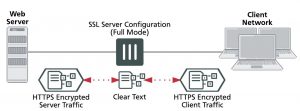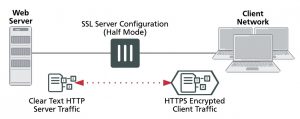Turning on web caching for HTTPS traffic
Web caching can also cache the content of HTTPS traffic on TCP port 443. With HTTPS web caching, the FortiGate unit receives the HTTPS traffic on behalf of the client, opens up the encrypted traffic and extracts content to be cached. Then FortiGate unit re-encrypts the traffic and sends it on to its intended recipient. It is very similar to a man-in-the-middle attack.
You enable HTTPS web caching from the CLI in a security policy or an explicit proxy policy that accepts the traffic to be cached using webcache-https. For a firewall policy:
config firewall policy edit 0
set webcache enable
set webcache-https any
end
For an explicit web proxy policy:
config firewall policy edit 0
set proxy web
set webcache enable
set webcache-https any
end
Web caching for HTTPS traffic is not supported if WAN optimization is enabled.
The any setting causes the FortiGate unit to re-encrypt the traffic with the FortiGate unit’s certificate rather than the original certificate. This configuration can cause errors for HTTPS clients because the name on the certificate does not match the name on the web site.
You can stop these errors from happening by configuring HTTPS web caching to use the web server’s certificate by setting webcache-https to ssl-server. This option is available for both firewall policies and explicit web proxy policies.
config firewall policy edit 0
set webcache enable
set webcache-https ssl-server
end
The ssl-server option causes the FortiGate unit to re-encrypt the traffic with a certificate that you imported into the FortiGate unit. You can add certificates using the following command:
In full mode the FortiGate unit is acting as a man in the middle, decrypting and encrypting the traffic. So both the client and the web server see encrypted packets.
Usually the port of the encrypted HTTPS traffic is always 443. However, in the SSL server configuration you can set the port used for HTTPS traffic. This port is not altered by the SSL Server. So for example, if the SSL Server receives HTTPS traffic on port 443, the re-encrypted traffic forwarded to the FortiGate unit to the server or client will still use port 443.
Half mode SSL server configuration
In half mode, the FortiGate unit only performs one encryption or decryption action. If HTTP packets are received, the half mode SSL server encrypts them and converts them to HTTPS packets. If HTTPS packets are received, the SSL server decrypts them and converts them to HTTP packets.
Half mode SSL server configuration
Where:
config wanopt ssl-server edit corporate-server
set ip <Web-Server-IP>
set port 443
set ssl-mode { full | half}
set ssl-cert <Web-Server-Cert>
end
Web-Server-IP is the web server’s IP address.
Web-Server-Cert is a web server certificate imported into the FortiGate unit.
The SSL server configuration also determines whether the SSL server is operating in half or full mode and the port used for the HTTPS traffic.
You can add multiple SSL server certificates in this way. When web caching processing an SSL stream if it can find a certificate that matches the web server IP address and port of one of the added SSL servers; that certificate is used to encrypt the SSL traffic before sending it to the client. As a result the client does not generate SSL certificate errors.
Web caching uses the FortiGate unit’s FortiASIC to accelerate SSL decryption/encryption performance.
Full mode SSL server configuration
The ssl-mode option determines whether the SSL server operates in half or full mode. In full mode the FortiGate unit performs both decryption and encryption of the HTTPS traffic. The full mode sequence is shown below.
Full mode SSL server configuration
In half mode, the FortiGate unit is acting like an SSL accelerator, offloading HTTPS decryption from the web server to the FortiGate unit. Since FortiGate units can accelerate SSL processing, the end result could be improved web site performance.
Usually the port of the encrypted traffic is always 443. However, in the SSL server configuration you can set the port used for HTTPS traffic. No matter what port is used for the HTTPS traffic, the decrypted HTTP traffic uses port 80.
Changing the ports on which to look for HTTP and HTTPS traffic to cache
By default FortiOS assumes HTTP traffic uses TCP port 80 and HTTPS traffic uses port 443. So web caching caches all HTTP traffic accepted by a policy on TCP port 80 and all HTTPS traffic on TCP port 443. If you want to cache HTTP or HTTPS traffic on other ports, you can enable security profiles for the security policy and configure a proxy options profile to that looks for HTTP and HTTPS traffic on other TCP ports. To configure a proxy options profile go to Network > Explicit Proxy.
Setting the HTTP port to Any in a proxy options profile is not compatible with web caching. If you set the HTTP port to any, web caching only caches HTTP traffic on port 80.


